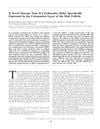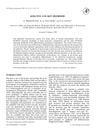TLDR Keratin 6a is important for quick wound healing from hair follicles.
The study investigated the role of keratin 6a (MK6a) in wound healing by creating MK6a-deficient mice. It was found that MK6a was normally induced in the outer root sheath and interfollicular epidermis upon wounding in wild-type mice, while MK6b was only induced in the suprabasal layers in MK6a-deficient mice. These knockout mice exhibited delayed reepithelialization from hair follicles after superficial wounding, although full-thickness skin wound healing was unaffected. In vitro, MK6a-deficient keratinocytes showed normal migration and proliferation. The findings suggested that MK6a was not crucial for keratinocyte proliferation or migration but played a role in activating follicular keratinocytes post-wounding. This was the first report of a keratin null mutation leading to a wound healing defect.
75 citations
,
October 1999 in “Differentiation” Mouse keratin 6 isoforms have different expression patterns in various tissues.
30 citations
,
October 1999 in “Differentiation” Mutant MK6a transgenes in mice cause blistering, hair loss, and potential human alopecia.
 139 citations
,
December 1998 in “The journal of investigative dermatology/Journal of investigative dermatology”
139 citations
,
December 1998 in “The journal of investigative dermatology/Journal of investigative dermatology” K6hf is a unique protein found only in a specific layer of hair follicles.
32 citations
,
November 1998 in “Journal of Biological Chemistry” Mouse and human keratin 16 can both form filaments, with differences likely due to the tail domain, not the helical domain.
318 citations
,
October 1998 in “The Journal of Cell Biology” Keratin 17 is important for skin development and may help define skin cell types.
79 citations
,
October 1998 in “Genomics” Mouse keratin 6 genes evolved independently from human ones and are regulated differently.
70 citations
,
March 1997 in “Journal of Investigative Dermatology”
 28 citations
,
April 1996 in “Cell biology international”
28 citations
,
April 1996 in “Cell biology international” Changes in keratin affect skin health and can lead to skin disorders like blistering diseases and psoriasis.
128 citations
,
February 1992 in “British Journal of Dermatology” Basal cell carcinomas likely originate from hair follicle cells or stem cells.
198 citations
,
November 1989 in “The Journal of Cell Biology” Keratin K14 expression varies between hair follicles and epidermis, affecting cell differentiation.

